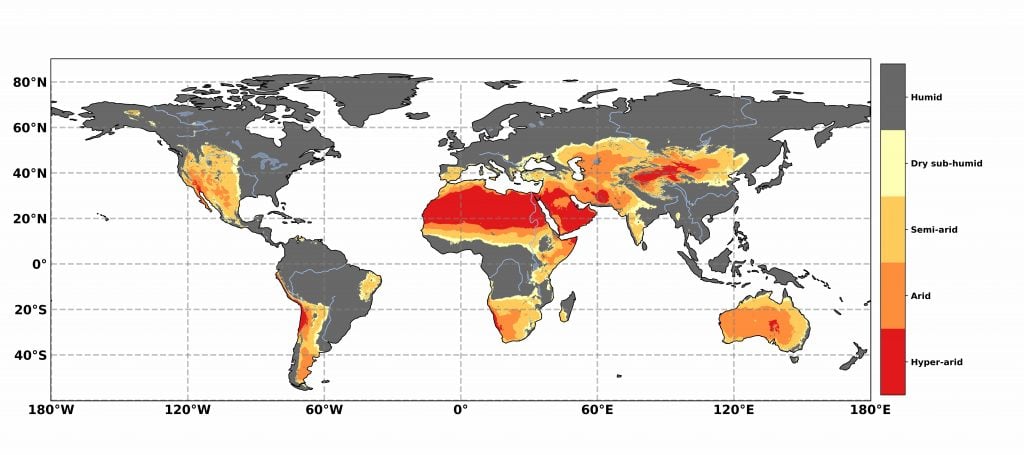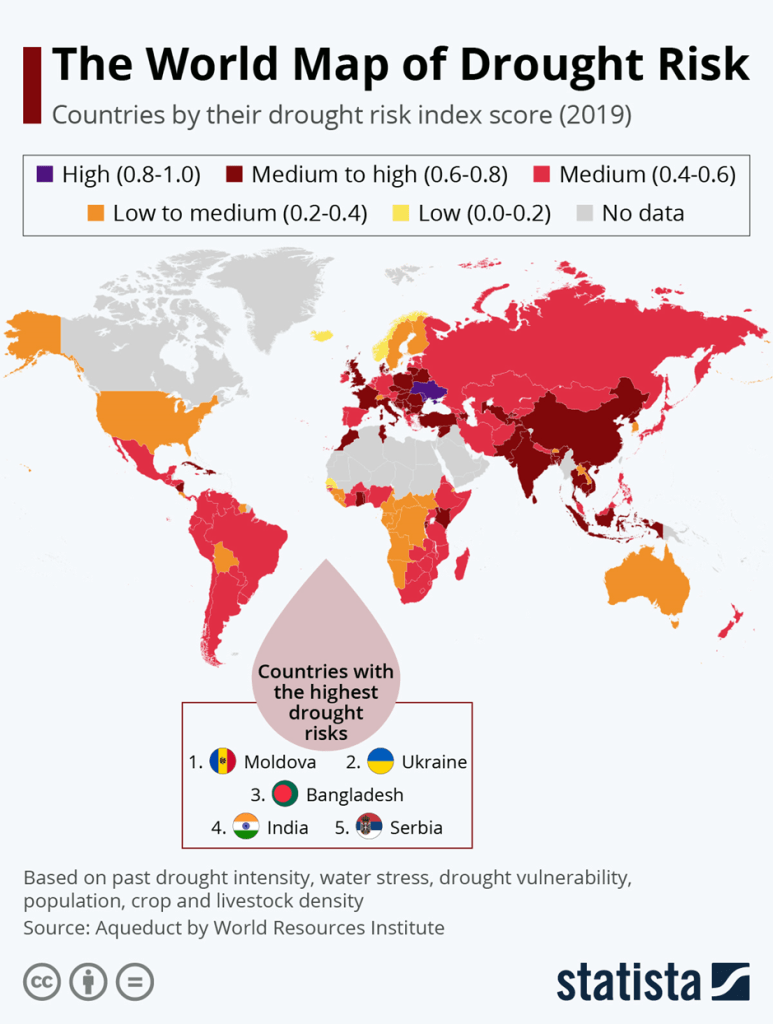Finding solutions for drought in a world increasingly affected by climate change depends upon first understanding the various types of drought that can affect eco systems.
What Is Drought?
The Impacts of Drought
- Agricultural losses,
- Fire hazards,
- Low water availability,
- Livestock damage
- Wildlife mortality and destruction of habitats.
Indirect effects include all the societal, environmental and economic consequences. For example, drought can affect:
- the risk of illnesses and death,
- human societies and mass migration.
Nevertheless, not all droughts generate disasters. They become a hazard only when the area cannot meet water demand. Risks increase the more the affected area fails to cope with water scarcity.

Mapping drought-prone areas
Natural climatic events and human management of water resources influence which regions are most susceptible to water stress.
Consequently, the likelihood of a drought varies across the globe. Governments, organisations, and specialists have been working on identifying those areas to help find better solutions for drought.
For example, the United Nations Developed Programme considers drylands as the most drought-prone areas. These cover 35 to 45% of the globe.

Drought hazard is highest for semi-arid areas. These regions include:
- Australia
- South America
- Southwestern and Horn of Africa
- the Amazon
- Southern Asia
However, low hazard locations may have a high drought risk, and vice-versa. This is because drought risks are related to the vulnerability of different socioeconomic sectors or ecosystems, and not necessarily linked to drought hazard (Carrão et al, 2016).

Water conservation lessons from drought-prone regions
Water conservation is everyone’s job. However, reducing the dependence on freshwater sources and improving management systems to improve national drought resilience are state-level tasks. There are many examples of projects that increase self-sufficiency and improve water management. Many of these come from some of the countries most vulnerable to drought.
Low water seeds, for example, have been developed for arid climates and are helping pave the way towards climate smart-agriculture.
There are many similar examples that show how we can tackle drought hazards and risks. They often involve technological solutions for drought and proactive government policies.
Drip Irrigation Systems in Israel
Israel is mostly desert and arid land. Consequently, the country has become a pioneer in water efficiency practice. One of the most successful strategies is the use of drip irrigation. This significantly reduces water dependence in agriculture.
Drip-irrigation, also known as micro-irrigation, was implemented in Israel decades ago. According to the leading company in the sector, the system was introduced in the 1960’s to support local yields of grapes, vegetables, and cotton.
The technique involves a set of pipes, pumps and filters that drip water directly onto the roots of the plants . It increases efficiency by supplying water and dissolved nutrients with precision. As a result, evaporation and wastage is reduced. (Megersa & Abdulahi, 2015). Drip irrigation can save up to 60% of water. Comparatively, traditional methods using sprinklers and flooding are very wasteful.
Costs and energy requirements are the main shortcomings of the technique. For this reason, gravity irrigation systems are emerging as a low-cost alternative. They need much less energy than conventional dripping setups. In gravity systems there is water stored meters above ground and it has enough pressure to naturally flow through the pipelines.

Wastewater recycling and reuse in Namibia
Namibia’s capital is closing the loop when it comes to water consumption. Located in one of the driest areas of the planet, the country suffers from permanent water stress. More than 40 years ago, Windhoek, the capital and largest city of Namibia, started transforming recycled sewage into potable water. Windhoek is the first city in the world to produce drinking water from wastewater.
The Goreangab Plant brings domestic and commercial sewage up to potable water standards. This is achieved through a multi-phased treatment system. According to an article published by Veolia in 2019, recycled wastewater meets 26% of Windhoek’s drinking water.
Given the long-term success of Namibia, direct potable water reuse is gaining attention in other parts of the world. Similarly, the US, South Africa and Australia are making their first moves towards their own recycling schemes. Meanwhile Singapore is already using sewage as a source of potable water.
Green Infrastructure in Western United States
Green infrastructure is also known as Low Impact Development (LID). It involves a set of design practices that reproduce natural processes in the management of stormwater. It is a strategy that can:
- Reduce runoff,
- Filter stormwater,
- Recharge aquifers,
- Improve table water quality
- and store rainwater.
Unlike conventional drainage engineering, green infrastructure has no finite lifespan.
The American Environmental Protection Agency (EPA) has been fostering LID practices. These include:
- Green roofs
- Rain gardens
- Permeable pavements
- Bioswales
These practices are encouraged within some of the most arid states in the US.
In California, the Central Coast Regional Water Quality Control Board requires municipal governments to adopt green infrastructure methodology. This aims to increase water quality, promote water conservation, and minimise degradation and wastage.
Los Angeles is saving U$23 million annually since the city ordered the storage of all rainwater runoff from volumes equal to or higher than 20 mm. The captured water replenishes the aquifer. This reduces the need for water imports and can cut costs.
In addition, the city has developed many “green street” projects. These consist of alleys equipped with sustainable solutions to store, treat and infiltrate the stormwater runoff. The components of the green streets include permeable pavement, bioswales, dry wells and raingardens.

Solutions for Drought in the Middle East and North Africa (MENA)
The MENA region is highly vulnerable to long periods of drought. Over the last two decades, the MENA drought project has been concentrating efforts to build an integrated drought management system (IDMS). Morocco, Lebanon and Jordan are currently using the system. Integrated drought management is an interconnected system that rapidly monitors and mitigates drought hazards at an early stage. It is based on a proactive approach to risk and disaster management.
Morocco’s integrated system addresses 3 main factors according to World Meteorological Organization:
- Monitoring an early drought warning system;
- Emergency operational plans to cope with negative drought impacts;
- Long-term strategies to reduce vulnerability to drought.
Investments in technical capacity to monitor weather has involved satellite-based maps. The maps allow users to detect emerging drought conditions.
The MENA project allows solutions for drought that are tailored to each country. Consequently, governments can make smart water management decisions. It can also aid planning for drought resilience measures .
A common ground for the future of water resources
Currently, 55 million people suffer from droughts each year. However, researchers estimate that climate change will increase the frequency, severity and impacts of droughts (Van Huijgevoort et al., 2013). Moreover, the IPCC states that overall water shortages and conflicts will increase throughout the globe.
It seems therefore that water security constitutes an international challenge. Thus, it becomes a task for all governments rather than only those in drought prone areas. In fact, many countries have already listed water as a main priority in their plans for climate change adaptation.
Further, a thematic session promoted by the World Bank has discussed alternatives to increase water efficiency with leaders of more than 90 countries.
“The presenters underlined that strong political will and sustained commitment at the highest level are prerequisites for changing behaviors that can ultimately improve the efficiency and sustainability of water usage in the long term.” World Bank
Sadly, it is not possible to control the climate. However, it is possible to avoid the disasters, deaths and losses caused by droughts. A report from the World Meteorological Organization reinforces the argument that integrated water management is the key to mitigating negative effects.
Solutions for drought prone regions are designed to address water-related issues in other areas of the world, regardless of different weather patterns. In short, enhancing frameworks to better manage water sources and uptaking water efficiency measures must become a global strategy
THRIVE is a not-for-profit organisation, for-impact social enterprise. Join the discussion this month on clean water and sanitation (SDG 6). Learn how you can do your bit by saving water at home. Also, check out our podcasts, webinar, and blogs for the latest sustainability news.























